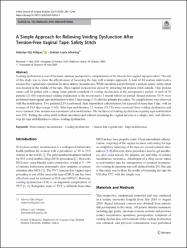| dc.contributor.author | Elçi Atılgan, Adeviye | |
| dc.contributor.author | Altuntaş, Şükriye Leyla | |
| dc.date.accessioned | 2021-10-07T08:45:52Z | |
| dc.date.available | 2021-10-07T08:45:52Z | |
| dc.date.issued | 2021 | en_US |
| dc.identifier.citation | Elçi Atılgan, A. ve Altuntaş, Ş. L. (2021). A simple approach for relieving voiding dysfunction after tension-free vaginal tape: Safety stitch. Indian Journal of Surgery, 83(5), 1241-1244. https://dx.doi.org/10.1007/s12262-020-02652-7 | en_US |
| dc.identifier.issn | 0972-2068 | |
| dc.identifier.issn | 0973-9793 | |
| dc.identifier.uri | https://dx.doi.org/10.1007/s12262-020-02652-7 | |
| dc.identifier.uri | https://hdl.handle.net/20.500.12511/8383 | |
| dc.description.abstract | Voiding dysfunction is one of the most common postoperative complications of the tension-free vaginal tape procedure. The aim of this study was to show the effectiveness of loosening the tape with a simple approach. A total of 84 women underwent a tension-free vaginal tape operation for stress urinary incontinence. While operation was performed, a prolene suture–safety stitch was inserted in the middle of the tape. Then vaginal incision was closed by extracting the prolene stitch outside. Thus prolene suture will be pulled with a clamp when patient complaint of voiding dysfunction at the postoperative period. A total of 18 patients (21.4%) experienced voiding dysfunction at the postoperative 1-month follow-up period. Sixteen patients (%19) were performed transvaginal tape mobilization within 3 days (range 1–5) after the primary procedure. No complications were observed with the mobilization. Two patients(2.3%) performed clean intermittent catheterization for a period of more than 1 day, with an average of 14.4 days (range 3–63). After tape mobilization, 15 women (93.7%) were recovered from voiding dysfunction and were continent. One woman was incontinent after mobilization. The incidence of voiding dysfunction requiring tape mobilization was 19%. Pulling the safety stitch without anesthesia and without reopening the vaginal incision is a simple, safe, and effective way for tape mobilization to relieve voiding dysfunction. | en_US |
| dc.language.iso | eng | en_US |
| dc.publisher | Springer | en_US |
| dc.rights | info:eu-repo/semantics/embargoedAccess | en_US |
| dc.subject | Stress Urinary Incontinence | en_US |
| dc.subject | Tape Mobilization | en_US |
| dc.subject | Tension-Free Vaginal Tape | en_US |
| dc.subject | Voiding Dysfunction | en_US |
| dc.title | A simple approach for relieving voiding dysfunction after tension-free vaginal tape: Safety stitch | en_US |
| dc.type | article | en_US |
| dc.relation.ispartof | Indian Journal of Surgery | en_US |
| dc.department | İstanbul Medipol Üniversitesi, Tıp Fakültesi, Cerrahi Tıp Bilimleri Bölümü, Kadın Hastalıkları ve Doğum Ana Bilim Dalı | en_US |
| dc.authorid | 0000-0003-4833-8978 | en_US |
| dc.authorid | 0000-0003-1985-552X | en_US |
| dc.identifier.volume | 83 | en_US |
| dc.identifier.issue | 5 | en_US |
| dc.identifier.startpage | 1241 | en_US |
| dc.identifier.endpage | 1244 | en_US |
| dc.relation.publicationcategory | Makale - Uluslararası Hakemli Dergi - Kurum Öğretim Elemanı | en_US |
| dc.identifier.doi | 10.1007/s12262-020-02652-7 | en_US |
| dc.identifier.wosquality | Q4 | en_US |
| dc.identifier.scopusquality | Q4 | en_US |


















